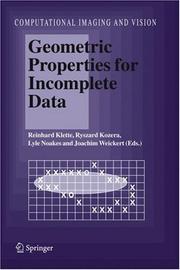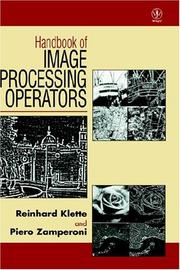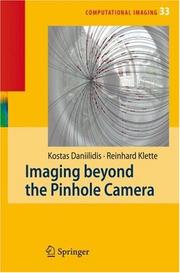| Listing 1 - 10 of 49 | << page >> |
Sort by
|

ISBN: 1280459956 9786610459957 1435601742 1402038585 1402038577 9048169828 Year: 2006 Volume: v. 31 Publisher: Dordrecht : Springer,
Abstract | Keywords | Export | Availability | Bookmark
 Loading...
Loading...Choose an application
- Reference Manager
- EndNote
- RefWorks (Direct export to RefWorks)
Computer vision and image analysis require interdisciplinary collaboration between mathematics and engineering. This book addresses the area of high-accuracy measurements of length, curvature, motion parameters and other geometrical quantities from acquired image data. It is a common problem that these measurements are incomplete or noisy, such that considerable efforts are necessary to regularise the data, to fill in missing information, and to judge the accuracy and reliability of these results. This monograph brings together contributions from researchers in computer vision, engineering and mathematics who are working in this area. The book can be read both by specialists and graduate students in computer science, electrical engineering or mathematics who take an interest in data evaluations by approximation or interpolation, in particular data obtained in an image analysis context.
Pattern perception --- Computer vision. --- Image processing --- Geometry --- Mathematics. --- Data processing. --- Machine vision --- Vision, Computer --- Artificial intelligence --- Pattern recognition systems --- Design perception --- Pattern recognition --- Form perception --- Perception --- Figure-ground perception --- Computer science --- Computer graphics. --- Computer Imaging, Vision, Pattern Recognition and Graphics. --- Computational Mathematics and Numerical Analysis. --- Computer Graphics. --- Approximations and Expansions. --- Math --- Science --- Automatic drafting --- Graphic data processing --- Graphics, Computer --- Computer art --- Graphic arts --- Electronic data processing --- Engineering graphics --- Computer mathematics --- Discrete mathematics --- Digital techniques --- Mathematics --- Optical data processing. --- Computer mathematics. --- Approximation theory. --- Theory of approximation --- Functional analysis --- Functions --- Polynomials --- Chebyshev systems --- Optical computing --- Visual data processing --- Bionics --- Integrated optics --- Photonics --- Computers --- Optical equipment
Book
ISBN: 1447163192 1447163206 Year: 2014 Publisher: London : Springer London : Imprint: Springer,
Abstract | Keywords | Export | Availability | Bookmark
 Loading...
Loading...Choose an application
- Reference Manager
- EndNote
- RefWorks (Direct export to RefWorks)
Many textbooks on computer vision can be unwieldy and intimidating in their coverage of this extensive discipline. This textbook addresses the need for a concise overview of the fundamentals of this field. Concise Computer Vision provides an accessible general introduction to the essential topics in computer vision, highlighting the role of important algorithms and mathematical concepts. Classroom-tested programming exercises and review questions are also supplied at the end of each chapter. Topics and features: Provides an introduction to the basic notation and mathematical concepts for describing an image, and the key concepts for mapping an image into an image Explains the topologic and geometric basics for analysing image regions and distributions of image values, and discusses identifying patterns in an image Introduces optic flow for representing dense motion, and such topics in sparse motion analysis as keypoint detection and descriptor definition, and feature tracking using the Kalman filter Describes special approaches for image binarization and segmentation of still images or video frames Examines the three basic components of a computer vision system, namely camera geometry and photometry, coordinate systems, and camera calibration Reviews different techniques for vision-based 3D shape reconstruction, including the use of structured lighting, stereo vision, and shading-based shape understanding Includes a discussion of stereo matchers, and the phase-congruency model for image features Presents an introduction into classification and learning, with a detailed description of basic AdaBoost and the use of random forests This concise and easy to read textbook/reference is ideal for an introductory course at third- or fourth-year level in an undergraduate computer science or engineering programme.
Computer vision --- Computer algorithms --- Engineering & Applied Sciences --- Applied Physics --- Machine vision --- Vision, Computer --- Computer science. --- Computers. --- Image processing. --- Computer Science. --- Image Processing and Computer Vision. --- Computing Methodologies. --- Computer vision. --- Artificial intelligence. --- Artificial Intelligence. --- Artificial intelligence --- Image processing --- Pattern recognition systems --- AI (Artificial intelligence) --- Artificial thinking --- Electronic brains --- Intellectronics --- Intelligence, Artificial --- Intelligent machines --- Machine intelligence --- Thinking, Artificial --- Bionics --- Cognitive science --- Digital computer simulation --- Electronic data processing --- Logic machines --- Machine theory --- Self-organizing systems --- Simulation methods --- Fifth generation computers --- Neural computers --- Computer algorithms. --- Optical data processing. --- Optical computing --- Visual data processing --- Integrated optics --- Photonics --- Computers --- Optical equipment
Digital
ISBN: 9781447163206 Year: 2014 Publisher: London Springer
Abstract | Keywords | Export | Availability | Bookmark
 Loading...
Loading...Choose an application
- Reference Manager
- EndNote
- RefWorks (Direct export to RefWorks)
Many textbooks on computer vision can be unwieldy and intimidating in their coverage of this extensive discipline. This textbook addresses the need for a concise overview of the fundamentals of this field. Concise Computer Vision provides an accessible general introduction to the essential topics in computer vision, highlighting the role of important algorithms and mathematical concepts. Classroom-tested programming exercises and review questions are also supplied at the end of each chapter. Topics and features: Provides an introduction to the basic notation and mathematical concepts for describing an image, and the key concepts for mapping an image into an image Explains the topologic and geometric basics for analysing image regions and distributions of image values, and discusses identifying patterns in an image Introduces optic flow for representing dense motion, and such topics in sparse motion analysis as keypoint detection and descriptor definition, and feature tracking using the Kalman filter Describes special approaches for image binarization and segmentation of still images or video frames Examines the three basic components of a computer vision system, namely camera geometry and photometry, coordinate systems, and camera calibration Reviews different techniques for vision-based 3D shape reconstruction, including the use of structured lighting, stereo vision, and shading-based shape understanding Includes a discussion of stereo matchers, and the phase-congruency model for image features Presents an introduction into classification and learning, with a detailed description of basic AdaBoost and the use of random forests This concise and easy to read textbook/reference is ideal for an introductory course at third- or fourth-year level in an undergraduate computer science or engineering programme.
Computer science --- Programming --- Information systems --- Computer. Automation --- computervisie --- beeldverwerking --- computers --- systeemontwikkeling (informatica) --- methodologieën --- computerkunde --- gegevensverwerking

ISBN: 0471956422 9780471956426 Year: 1996 Publisher: Chichester Wiley
Abstract | Keywords | Export | Availability | Bookmark
 Loading...
Loading...Choose an application
- Reference Manager
- EndNote
- RefWorks (Direct export to RefWorks)

ISBN: 1280716452 9786610716456 1402048947 1402048939 9048172209 Year: 2006 Volume: v. 33 Publisher: Dordrecht : Springer,
Abstract | Keywords | Export | Availability | Bookmark
 Loading...
Loading...Choose an application
- Reference Manager
- EndNote
- RefWorks (Direct export to RefWorks)
The world's first photograph was taken in 1826 using a pinhole camera called camera obscura. Cameras used since then are basically following the pinhole camera principle. This book looks at the development as well as the applications of alternative camera architectures.
Image processing --- Catadioptric systems. --- Cameras --- Digital techniques. --- Calibration. --- Catadioptric lenses --- Mirror lenses --- Systems, Catadioptric --- Imaging systems --- Lenses --- Telescopes --- Digital image processing --- Digital electronics --- Information Technology --- Computer Science (Hardware & Networks) --- Photography. --- Computer science. --- Computer vision. --- Artificial intelligence. --- Computer Science, general. --- Image Processing and Computer Vision. --- Artificial Intelligence. --- Computer Imaging, Vision, Pattern Recognition and Graphics. --- AI (Artificial intelligence) --- Artificial thinking --- Electronic brains --- Intellectronics --- Intelligence, Artificial --- Intelligent machines --- Machine intelligence --- Thinking, Artificial --- Bionics --- Cognitive science --- Digital computer simulation --- Electronic data processing --- Logic machines --- Machine theory --- Self-organizing systems --- Simulation methods --- Fifth generation computers --- Neural computers --- Machine vision --- Vision, Computer --- Artificial intelligence --- Pattern recognition systems --- Informatics --- Science --- Optical data processing. --- Optical computing --- Visual data processing --- Integrated optics --- Photonics --- Computers --- Optical equipment
Book
ISBN: 1447122550 1447160649 9786613477217 1447122569 1283477211 Year: 2011 Publisher: London : Springer,
Abstract | Keywords | Export | Availability | Bookmark
 Loading...
Loading...Choose an application
- Reference Manager
- EndNote
- RefWorks (Direct export to RefWorks)
The Euclidean shortest path (ESP) problem asks the question: what is the path of minimum length connecting two points in a 2- or 3-dimensional space? Variants of this industrially-significant computational geometry problem also require the path to pass through specified areas and avoid defined obstacles. This unique text/reference reviews algorithms for the exact or approximate solution of shortest-path problems, with a specific focus on a class of algorithms called rubberband algorithms. Discussing each concept and algorithm in depth, the book includes mathematical proofs for many of the given statements. Suitable for a second- or third-year university algorithms course, the text enables readers to understand not only the algorithms and their pseudocodes, but also the correctness proofs, the analysis of time complexities, and other related topics. Topics and features: Provides theoretical and programming exercises at the end of each chapter Presents a thorough introduction to shortest paths in Euclidean geometry, and the class of algorithms called rubberband algorithms Discusses algorithms for calculating exact or approximate ESPs in the plane Examines the shortest paths on 3D surfaces, in simple polyhedrons and in cube-curves Describes the application of rubberband algorithms for solving art gallery problems, including the safari, zookeeper, watchman, and touring polygons route problems Includes lists of symbols and abbreviations, in addition to other appendices This hands-on guide will be of interest to undergraduate students in computer science, IT, mathematics, and engineering. Programmers, mathematicians, and engineers dealing with shortest-path problems in practical applications will also find the book a useful resource. Dr. Fajie Li is at Huaqiao University, Xiamen, Fujian, China. Prof. Dr. Reinhard Klette is at the Tamaki Innovation Campus of The University of Auckland.
Computational complexity. --- Computer aided design. --- Computer science. --- Computer science -- Mathematics. --- Computer software. --- Electronic data processing. --- Euclidean algorithm. --- Optical pattern recognition. --- Graph algorithms --- Mathematics --- Engineering & Applied Sciences --- Physical Sciences & Mathematics --- Algebra --- Computer Science --- Mathematical analysis. --- Algebraic spaces. --- Spaces, Algebraic --- 517.1 Mathematical analysis --- Mathematical analysis --- Algorithm of Euclid --- Continued division --- Division, Continued --- Euclid algorithm --- Euclidian algorithm --- Euclid's algorithm --- Algorithms. --- Numerical analysis. --- Computer science --- Pattern recognition. --- Computer-aided engineering. --- Computer Science. --- Algorithm Analysis and Problem Complexity. --- Numeric Computing. --- Pattern Recognition. --- Discrete Mathematics in Computer Science. --- Math Applications in Computer Science. --- Computer-Aided Engineering (CAD, CAE) and Design. --- Mathematics. --- Geometry, Algebraic --- Algorithms --- Number theory --- CAD (Computer-aided design) --- Computer-assisted design --- Computer-aided engineering --- Design --- Informatics --- Science --- Complexity, Computational --- Electronic data processing --- Machine theory --- Optical data processing --- Pattern perception --- Perceptrons --- Visual discrimination --- ADP (Data processing) --- Automatic data processing --- Data processing --- EDP (Data processing) --- IDP (Data processing) --- Integrated data processing --- Computers --- Office practice --- Software, Computer --- Computer systems --- Automation --- Computer science—Mathematics. --- CAE --- Engineering --- Design perception --- Pattern recognition --- Form perception --- Perception --- Figure-ground perception --- Algorism --- Arithmetic --- Foundations
Book
ISBN: 3319505513 3319505491 Year: 2017 Publisher: Cham : Springer International Publishing : Imprint: Springer,
Abstract | Keywords | Export | Availability | Bookmark
 Loading...
Loading...Choose an application
- Reference Manager
- EndNote
- RefWorks (Direct export to RefWorks)
This book summarises the state of the art in computer vision-based driver and road monitoring, focussing on monocular vision technology in particular, with the aim to address challenges of driver assistance and autonomous driving systems. While the systems designed for the assistance of drivers of on-road vehicles are currently converging to the design of autonomous vehicles, the research presented here focuses on scenarios where a driver is still assumed to pay attention to the traffic while operating a partially automated vehicle. Proposing various computer vision algorithms, techniques and methodologies, the authors also provide a general review of computer vision technologies that are relevant for driver assistance and fully autonomous vehicles. Computer Vision for Driver Assistance is the first book of its kind and will appeal to undergraduate and graduate students, researchers, engineers and those generally interested in computer vision-related topics in modern vehicle design. .
Driver assistance systems. --- Computer vision. --- Machine vision --- Vision, Computer --- Mathematics. --- Image processing. --- Pattern recognition. --- Computer science --- Computer mathematics. --- Mathematical Applications in Computer Science. --- Image Processing and Computer Vision. --- Pattern Recognition. --- Artificial intelligence --- Image processing --- Pattern recognition systems --- Automobiles --- Sociotechnical systems --- Electronic equipment --- Optical pattern recognition. --- Optical data processing --- Pattern perception --- Perceptrons --- Visual discrimination --- Computer science—Mathematics. --- Optical data processing. --- Design perception --- Pattern recognition --- Form perception --- Perception --- Figure-ground perception --- Optical computing --- Visual data processing --- Bionics --- Electronic data processing --- Integrated optics --- Photonics --- Computers --- Computer mathematics --- Mathematics --- Optical equipment

ISBN: 128101012X 9786611010126 0080477267 1558608613 1493303724 1417561718 9781417561711 159278237X 9781592782376 9781558608610 9780080477268 9781281010124 6611010122 Year: 2004 Publisher: Amsterdam Boston Elsevier
Abstract | Keywords | Export | Availability | Bookmark
 Loading...
Loading...Choose an application
- Reference Manager
- EndNote
- RefWorks (Direct export to RefWorks)
Digital geometry is about deriving geometric information from digital pictures. The field emerged from its mathematical roots some forty-years ago through work in computer-based imaging, and it is used today in many fields, such as digital image processing and analysis (with applications in medical imaging, pattern recognition, and robotics) and of course computer graphics. Digital Geometry is the first book to detail the concepts, algorithms, and practices of the discipline. This comphrehensive text and reference provides an introduction to the mathematical foundations of digital geome
Image processing --- Geometry --- Image analysis. --- Computer graphics. --- Algorithms. --- Digital techniques. --- Data processing. --- Algorism --- Automatic drafting --- Graphic data processing --- Graphics, Computer --- Analysis of images --- Image interpretation --- Digital image processing --- Algebra --- Arithmetic --- Computer art --- Graphic arts --- Electronic data processing --- Engineering graphics --- Imaging systems --- Digital electronics --- Foundations --- Digital techniques --- Photographs --- Forensic sciences --- Inspection
Digital
ISBN: 9781402048944 Year: 2006 Publisher: Dordrecht Springer
Abstract | Keywords | Export | Availability | Bookmark
 Loading...
Loading...Choose an application
- Reference Manager
- EndNote
- RefWorks (Direct export to RefWorks)
Multi
ISBN: 9783540781578 Year: 2008 Publisher: Berlin, Heidelberg Springer-Verlag Berlin Heidelberg
Abstract | Keywords | Export | Availability | Bookmark
 Loading...
Loading...Choose an application
- Reference Manager
- EndNote
- RefWorks (Direct export to RefWorks)
Discrete mathematics --- Mathematical statistics --- Computer science --- Artificial intelligence. Robotics. Simulation. Graphics --- Computer. Automation --- patroonherkenning --- beeldverwerking --- factoranalyse --- discrete wiskunde --- grafische vormgeving --- informatica --- robots
| Listing 1 - 10 of 49 | << page >> |
Sort by
|

 Search
Search Feedback
Feedback About UniCat
About UniCat  Help
Help News
News